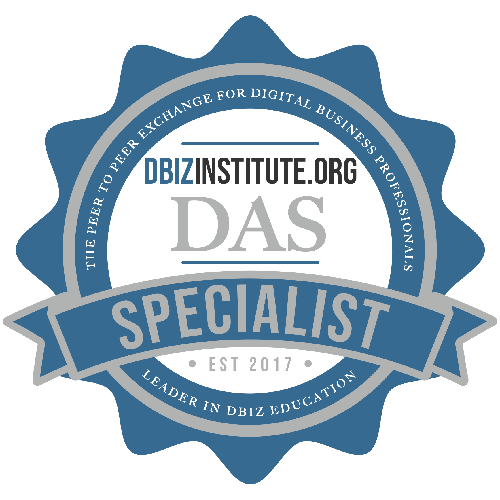Home / Resources
Resources
Discover a Wealth of BPM Knowledge and Expertise at BPMInstitute.org!

OMG Seeking Decision Model Notation Standard
A lot has happened in the last year regarding The Decision Model. In November 2009, our book described the formalism and usage of The Decision Model (von Halle and Goldberg, 2009, Taylor & Francis LLC, The Decision Model: A Business Logic Framework Linking business and Technology). Since then, adoption of The Decision Model has escalated faster than anticipated. It also caught the attention of the Object Management Group which is the subject of this month’s column.

Measuring System Quality
How should the quality of a system be measured? More particularly, how should quality be ascertained when the system is complex and incorporates important components not readily evaluated by quantitative means?
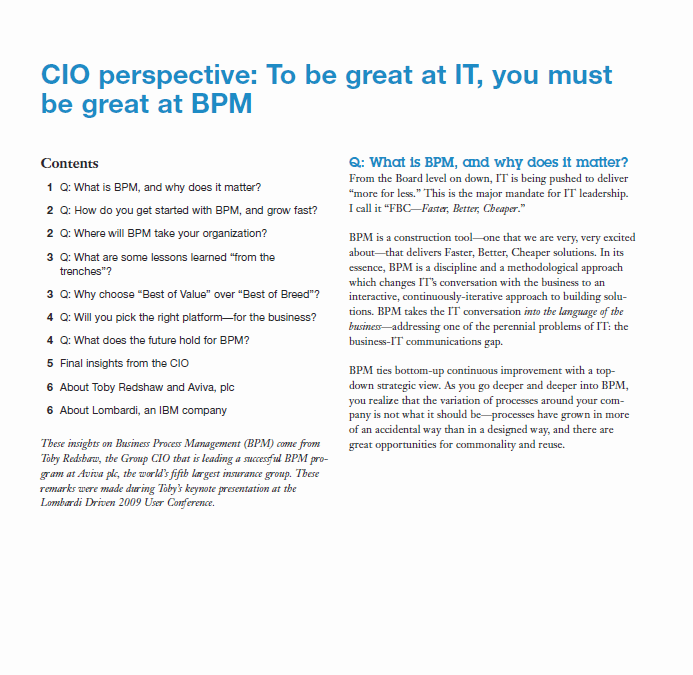
CIO perspective: To be great at IT, you mustbe great at BPM
Read this paper for expert insights on Business Process Management (BPM) from Toby Redshaw, the Group CIO that is leading a successful BPM program at Aviva plc, the world’s fifth-largest insurance group. The remarks contained here were made during Toby’s keynote presentation at the Lombardi Driven 2009 User Conference.

A New Order of Things with the Business Architecture
The Business Architecture (BA) is a bold and challenging initiative, that when undertaken by visionary and innovative leaders of the enterprise brings about a “new order of things.”

Out-SOA-cing – The Challenge of Outsourcing SOA
With the current hard times continuing to challenge IT budgets, I fear that all the good effort that is going into SOA currently could be squandered by ill-conceived or rushed outsourcing of the wrong services and wrong responsibilities at the wrong time to the few remaining IT service companies.
It is worth pointing out that the analyst community have consistently promoted SOA and outsourcing as being good bedfellows. There are two main models here:

The Decision Model Column – “MIT Industry Symposium on Information Quality, The Decision Model, and an IQ Framework”
(This article assumes knowledge of The Decision Model.

OD or BPM: Pick Only One?
Organizational life is not a natural act. We humans are well suited for the mostly faceto- face interaction of the medium-sized tribe; everything beyond that is a push. It is not surprising that we often find that our organizations do not function as neatly as we might hope. Faced with this challenge, business leaders today have a perplexing choice: Should they work on the work (BPM) or work on the worker (OD)?
Organizational development – one side of this artificial divide – has long pushed for a focus on people.

Is Your Enterprise Out of Control?
Before answering this question, consider for a moment: What does “out of control” mean? Someone responding with a broad, long winded answer might refer to Kevin Kelly’s most excellent and timeless book titled Out of Control (1). In a simpler context, please consider the building of a high rise office building or the addition of a large family room, sunroom, patio and pool to an existing house without the benefit of a “blueprint” developed by an architect? Does “out of control” come to mind?
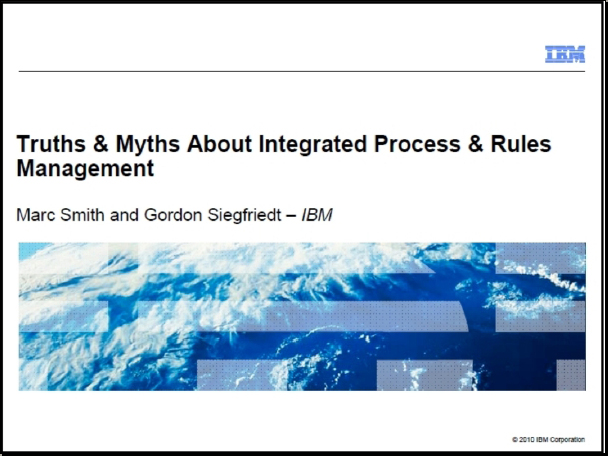
Truths and Myths About Integrated Process and Rules Management
Many companies agree that Business Process Management along with Business Rules Management are a powerful combination for process improvement within an organization. But some approaches to integrating process and rules management are more effective than others. This presentation takes a quick look at truths – and myths – about integrated process and rules management. We will recommend and demonstrate one particular approach that maximizes flexibility and ease-of-management as your process improvement program scales across the enterprise.

The Hybrid SDLC
The purpose of this article is to provide project managers and business analysts an example of a hybrid system development life cycle (i.e., combination of agile and waterfall). Much discussion has transpired on the virtues of agile and waterfall approaches. Successes and failures can be claimed on both sides. Depending on the conditions of the project, advantages of one approach can be cited over the other. So enters the Hybrid SDLC that considers both approaches for all or portions of the project.
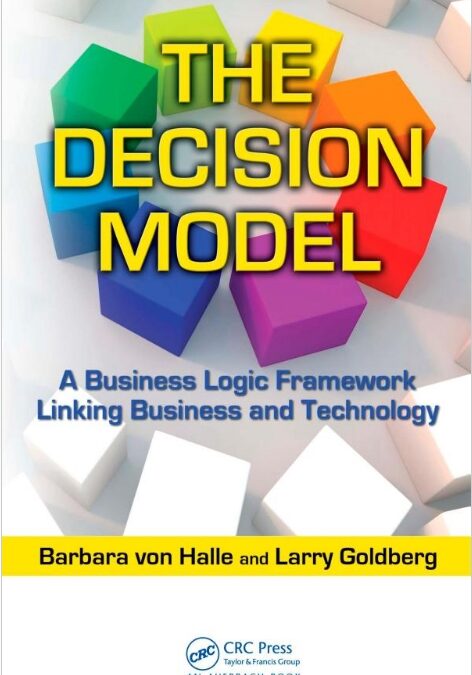
The Decision Model
Chapter 4: Changing the Game: BPM and BDM
Because business logic is such an important but overlooked business asset, the Decision Model delivers significant value to all activities that involve important business decisions. Therefore, the Decision Model’s impact is significantly wide-spanning business and IT projects and strategic to operational business issues. This chapter presents insights into the impact that the Decision Model has had on BPM and BDM and some insights into the future.

BPM: Toolbox for a Bionic Enterprise
Towards a Bionic World
Whatever at individual or social level, our biologic functions are more and more supported, if not replaced, by technology. Sometimes to mitigate physical or sensory deficiencies through mobility aids or improvement of auditive, visual capacities. In other occasions, electronics offer opportunities that our biological configuration cannot assume, at least for the time being all this evolution is transferring human processes from the biologic or physical world to another electronic or virtual one.

Improving the Business Operation – A Mixed Job
Business operations and their IT support are built to deliver effective outcomes from a variety of activities. Although, most companies have used focused projects to improve the cost and quality of different parts of the business, many managers believe that operations are not really designed for efficiency. Part of the problem is that over years of efficiency driven piecemeal change in both business and IT areas, the overall processes have often deteriorated and their effectiveness has often become questionable.

Three Secrets to Engaging Business and IT in Business Process Management
BPM is unique in offering so much promise while being so generally ignored. Even among companies that actively pursue some level of process improvement, only a few have a process based management structure. At least one reason for our tepid impact is our failure to model an enterprise-wide perspective in the initial launch of process improvement efforts. Gartner Inc. reports that in North America IT leads 42% of the BPM efforts and the Business leads 58% of the efforts.

Process Management Center of Excellence: Who Does What?
1. INTRODUCTION
Organizations have been trying to define who will be accountable for process management tasks[1]. This definition can: improve business performance; balance the power distribution among organization units; and engage important and different internal stakeholders. My previous articles provide guidelines on how to design the process center of excellence – PCE [3] [5]. This article provides guidance to support the decision on which organization unit can be responsible for the activities in the process management value chain.

Modeling a Net-Centric Department of Defense (DoD) Enterprise using BPMN 2.0
If a picture is a worth a thousand words, a standardized model is definitely worth multiple pages of a requirement specification. Business and IT have long used tabular descriptions, flowcharts and other means to capture and describe how their business processes are run, but if a modeling format has to go beyond being just a sketch, it requires a standardized, non-proprietary notation which can be uniformly understood by all.

The Business Architecture (BA) Paradigm
Interest in Business Architecture (BA) initiatives, case study presentations and training classes are increasing, a sign of a maturing and evolving approach.

Passing the Torch
In First Things First, I made a case for partitioning the front end of the development process into a concept planning phase and a detail design phase. In effect, this separates the “what” from the “how” in the process of creating and giving form to an idea.
The value of this is multifold:
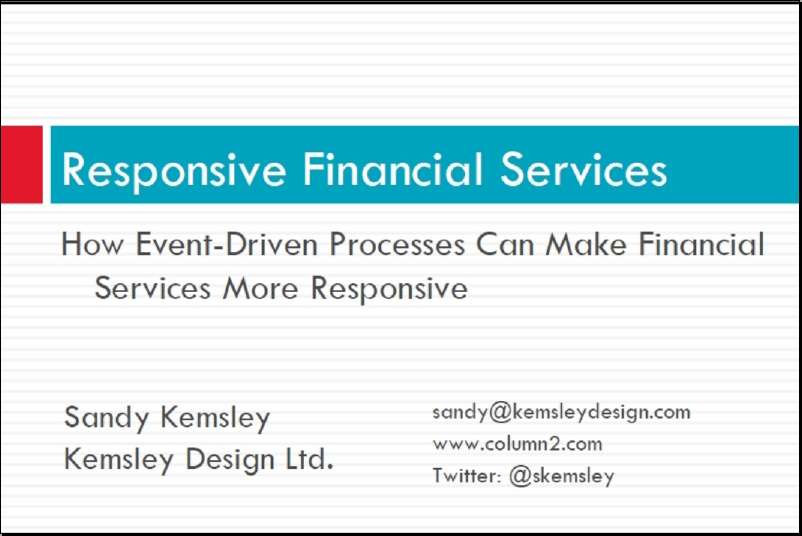
Making Financial Services More Responsive
This webinar will discuss how to make your financial service organization more responsive to customers, opportunities and threats through event-driven processes in business process management (BPM). This will include the importance and meaning of events relative to a business process and the links between BPM and complex event process (CEP).

The Service Oriented Architecture Enterprise Architecture Framework (SOA~EAF)
Enterprise Architecture as a practice has been around for some time now. Many companies have reached a level of sophistication and maturity within their EA practices. They are well established with EA policies and governance institutionalized throughout the company.













